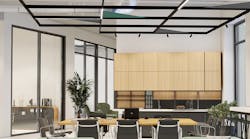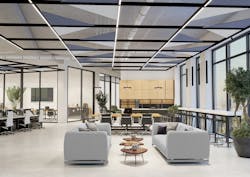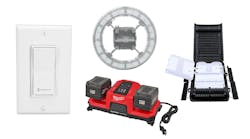Lighting designers today have moved away from using drop ceilings in offices because they don’t allow for design freedom, plus they make the space feel smaller. Instead, they’re opting for open ceilings that permit design creativity, flexibility, and the perception of a larger space. These open ceilings, coupled with the need for flexible office space configurations, present an opportunity for innovative and dynamic lighting systems.
Office design trends
The growing trend in office designs is to accommodate ever-changing and future-proofing configurations – whether a person is working alone at a desk, in a small pod in a lounge area, with a group in a conference room, rejuvenating at the coffee bar, or taking a break in the exercise room. Present and future offices must be transformative and flexible to address these diverse work environments. This theory is supported by a study conducted by Knoll, “The Case for a Thriving Workplace,” which provides compelling evidence that workforce performance and well-being considerations are largely driving the form and use of the future workplace. Based on the responses, Knoll also concluded that “further supporting flexibility, the average percentage of unassigned workspaces will more than double…”. Read the full report at https://bit.ly/3wA660P.
If businesses expect to attract and retain a productive and engaged workforce, they will need to rethink the future of the office to emphasize flexibility. To provide a truly inclusive experience when redesigning a space, the future office will need to cater to all types of workers. The traditional, functional office space will shift to a workspace designed around social interaction, collaboration, and relationship building. A greater emphasis will be placed on technology and spaces that encourage face-to-face interaction as the future of work evolves.
Architects across the world are tackling the question of the post-pandemic office space as well. For example, in an article in Surface Magazine, “The Future of Work Might Look Like This,” five architectural firms envision a paradigm shift toward a more resilient and flexible office space hub in place of permanent, large open-air office spaces. Read the full article at https://bit.ly/3Lh3XeA.
Why lighting is important
In partnership with Cornell University, Delos, and the Innovative Workplace Institute, the American Society of Interior Designers (ASID) researched the impact of innovative workplace design on behavior and performance, how spatial design supports organizational goals, and the impact of design on human, organizational, and environmental sustainability. According to the article, “Bad Mood in the Workplace? Try Changing the Lights,” written by Jeff Pochepan and featured in Inc. magazine, the study showed that 68% of employees were dissatisfied with the lighting situation in their offices. Read the full article at https://bit.ly/3IL9mJu.
Given that workers spend about one-third of their day in the office, inadequate lighting has a detrimental effect on employees by causing eye strain, poor spirits, lackluster energy levels, and low productivity. Cortisol levels drop significantly under artificial or poor lighting conditions, which means people may be more stressed and have less ability to stabilize energy levels. To combat these realities, thoughtful lighting design can support organizational priorities, such as employee health, productivity, and financial return. By incorporating multiple innovative features, like flexible lighting, the design can positively affect the health and well-being of employees while boosting resource efficiency.
Adaptable and innovative lighting
Since lighting is essential in every built environment, lighting designs must be adaptable to office reconfigurations and future changes in site layout. Dynamic lighting not only supports resilience, flexibility, and well-being, but it also provides a future-proof solution to deal with changes. Flexible designs – and lighting – necessitate the increased mobility of people and facilities.
Today more than ever, a successful workplace needs to be resilient – it has to be flexible and nimble enough to handle anticipated and unanticipated change, able to support employee well-being, and poised to continue to add value over time. Read “How Flexible Lighting Helps Define the Resilient Workspace” by Matt Ochs in Work Design Magazine for more information at https://bit.ly/3tKQLZC.
Businesses must incorporate new office design strategies and embrace the new workplace dynamic to achieve future-proof solutions. Complementing these new office design strategies is dynamic lighting, which addresses the unexpected and offers designers a solution for creating flexible spaces that are better prepared for whatever changes and challenges lie ahead.
Howard Yaphe, CEO Axis Lighting, has more than 35 years of experience in the lighting industry and may be reached at [email protected].




